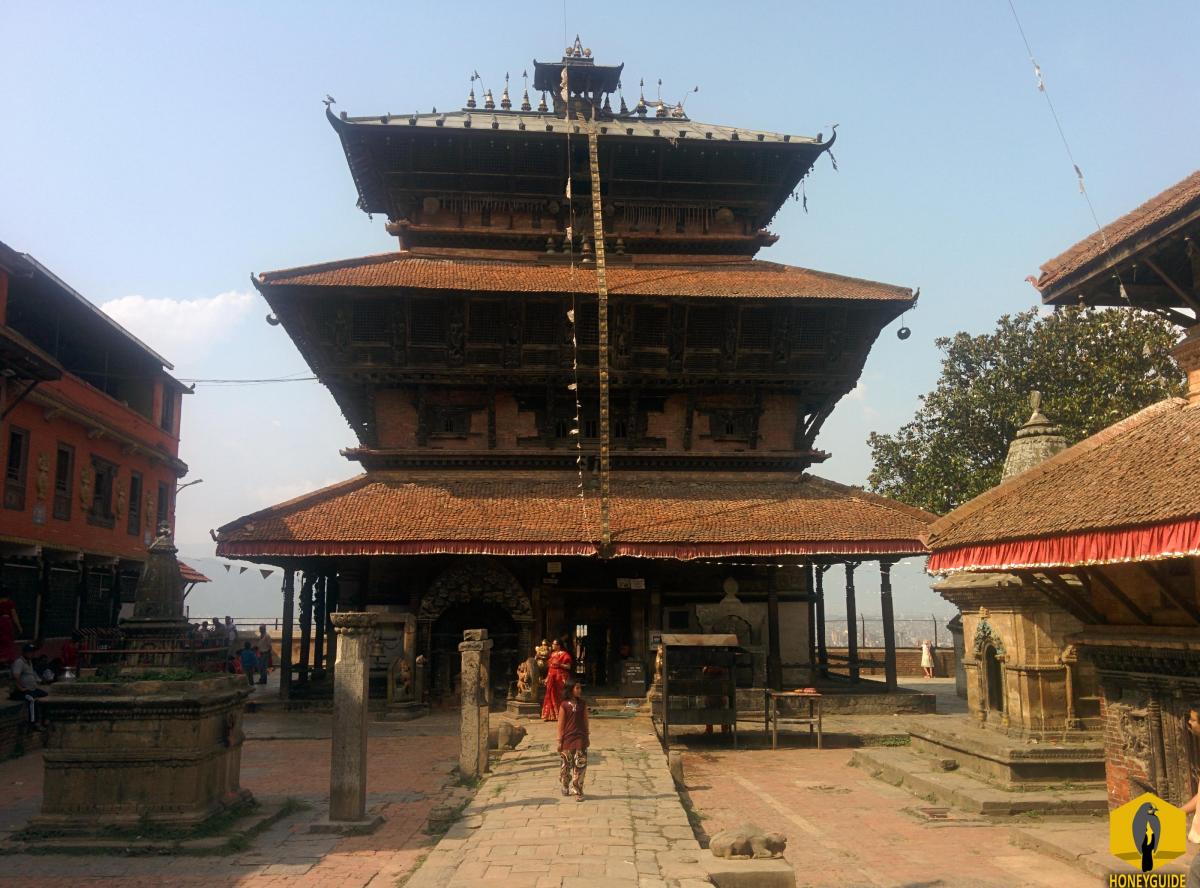Bagh Bhairav temple, one of the oldest shrines in Kirtipur is known for the guardian deity, Bhairav in form of a tiger. The main statue and icon is composed of clay with a large silver mask with depiction of Bhairav. As corroborated by historical facts, the mask was offered by a kirtipur resident named Chaturman Dware during Chandra Shumsher’s reign.
Also known as Aju Deu in local Newari language, which translates to Grandfather God, the clay statue is known to degrade due to natural causes. Hence it is replaced with a new one every twenty to thirty years. This sacred act can only be performed by a buddhist priest of Bajracharya clan. Final clay mix before mould must contain clays from seven different holy sites. One of the seven sacred site is Mhaipi, which was the most significant of sacred pilgrimages before Buddhist and modern Hindu era.
There are many small temples within Bagh Bhairav complex like most big temples in Nepal. The small ones each have a deity: Ganesh, Barahi, Kumari, Bhramhayani, Vaishnavi, Shiva & Parbati, and a standing Shiva. Also within the complex is a small temple of Kriti Mata with a statue of her giving birth to an unknown creature. She is widely regarded as the mother of Kirtipur. The temple of Narayan, the medium sized white one of Moughal style (also known as Gumbaz style), along with De Pukhu pond just beside it were also part of Bagh Bhairav complex. The latter two are outside of the complex today thanks to modern town planning.
Bagh Bhairav temple itself has some unique features. Offering weapons of defeated enemies were perceived to be appropriate offerings to the tiger like fierce protector deity. The topmost tier of the temple is decorated with weapons of defeated enemies of Kirtipur. Most of the swords and other weapons up there are of fallen soldiers of Prithivi Narayan Shah’s first and second attacks on Kirtipur, both of which failed.
Surviving inscriptions found in different assets of the temple like bell, supporting pillars, golden flag gives irrefutable evidences that the temple was renovated many times, sometimes with additions on to structures built back many years before. But there is no evidence that marks the date or the person that established the temple. But a genealogical scripture does mention the date of establishment of Kirtipur and Bagh Bhairav with the difference of just one year. The establishment of Kirtipur according to Gopal Raj genealogy, was by the King Shiva Deva III who ruled Nepal valley from 1099-1126 AD. So the date of Bagh Bhairav’s establishment can logically be claimed to have happened within the period.
Story of Bagh Bhairav:
The story of the origin of the Bagh Bhairav, as believed by the people is inordinate and it goes accordingly: “The shepherds children were grazing their sheeps in the forest that lies on the northern slope of Kirtipur , as usual they used to be engaged in the play of moulding the clay in different forms. One day they made a tiger and in search of a leaf that resembles a tongue in shape, they headed inside the jungle. It so happened that Lord Shiva, after a long walk with his son Ganesh, stopped near the clay tiger. While Ganesh wandered off into the think forest, Shiva grew hungry and as time passed further he gave into the temptation. Through mystical powers he merged his soul and body into the clay tiger which then came to life and devoured the sheeps. Seeing splattered blood and scattered bones upon their return, the shepherds searched for clues. Close inspection of the tiger revealed blood inside its mouth. When the children asked the clay tiger if he had actually devoured all the sheeps, it opened its mouth wide. Angered by the loss of their sheeps, the tiger was never given a tongue. Hence, all images and statues of Bagh Bhairav are missing tongues. Legend has it that the form of deity still desires a tongue.”
Renovations:
Bagh Bhairav Temple has had many renovations since its establishment as revealed in the table below:
| Date | Renovations | Renovated by |
|---|---|---|
| 1515 A.D. | Byaghrevara’s residence | Unknown |
| 1587 A.D. | Golden Kalasha was made | Unknown |
| 1660 A.D. | Moharamala offered | Unknown |
| 1691 A.D. | Bell on the right side of Hi Fa Dya Bell on the right side of Hi Fa Dya (Sacrificing altar) |
Unknown |
| 1693 A.D. | Torana was offered | Unknown |
| 1694 A.D. | Mahadeepa was instituted | Unknown |
| 1697 A.D. | Tympanum was donated | Unknown |
| 1703 A.D. | Main entrance was covered with copper sheet plated with gold and small Chakra was fixed on the wall. |
Unknown |
| 1717 A.D. | Two main stone figures of Hanuman were erected | Unknown |
| 1762 A.D. | Entrance door renovated and garland of coins offered | Unknown |
| 1803 A.D. | Bells installed which weigh 70.5 kg | Manandhara Jog Man |
| 1854 A.D. | Supporting pillars between the trellis windows on the second floor |
Unknown |
| 1902 A.D. | A golden flag on the right of the main entrance was added | Unknown |
| 1921 A.D. | Covering of the main lions with metal sheet coated with gold |
Unknown |
| 1936 A.D. | Major Decoration. Covered the whole area on the ground floor in front of the God and all four sides of the wall as well, with the brass sheet. |
Local citizen Santavir Bhawo of mwanatole |
| 1964 A.D. | Another golden flag at the left of the main entrance was offered |
Unknown |
| 1967 A.D. | Metal sheets on the floor level were replaced by the Godavari marble inside the temple |
Guthi Sansthan, an organization of His Majesty’s Government of Nepal |









